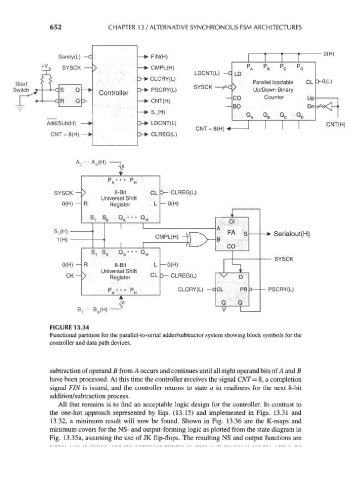Page 684 - Engineering Digital Design
P. 684
652 CHAPTER 13 / ALTERNATIVE SYNCHRONOUS FSM ARCHITECTURES
0(H)
Sanity(L) - FIN(H)
+V s SYSCK — CMPL(H) P A r P r P r D
P
r
B
C
LDCNT(L) LD
CLCRY(L)
Start Parallel loadable CL >0(L)
Switch PSCRY(L) SYSCK Up/Down Binary
Controller
CO Counter up
CNT(H)
BO Dn
Add/Sub(H) » LDCNT(L) CNT(H)
CNT = 8(H)
CNT = 8(H) » CLREG(L)
"7 " 0" ''
8
p . . . p
r r
A H
SYSCK — )> 8-Bit CL >- CLREG(L)
Universal Shift
0(H)- R Register L -0(H)
1
S b Q U O ' • » f~}
U
1 O A H
Cl
I A _.
S^H) ' — ^ Serialout(H)
CMPL(H) -^ ^^ FA s
B
CO
1 0 A H
SYSCK
0(H)- R 8-Bit L -0(H) L,
, Universal Shift
CK — / Register CL 3- CLREG(L) v D
p . . . p CLCRY(L) — C CL PR D — PSCRY(L)
r r
A H
\ 8 Q Q
B 7 -B 0 (H) h V 1 1
FIGURE 13.34
Functional partition for the parallel-to-serial adder/subtractor system showing block symbols for the
controller and data path devices.
subtraction of operand B from A occurs and continues until all eight operand bits of A and B
have been processed. At this time the controller receives the signal CNT= 8, a completion
signal FIN is issued, and the controller returns to state a in readiness for the next 8-bit
addition/subtraction process.
All that remains is to find an acceptable logic design for the controller. In contrast to
the one-hot approach represented by Eqs. (13.15) and implemented in Figs. 13.31 and
13.32, a minimum result will now be found. Shown in Fig. 13.36 are the K-maps and
minimum covers for the NS- and output-forming logic as plotted from the state diagram in
Fig. 13.35a, assuming the use of JK flip-flops. The resulting NS and output functions are

